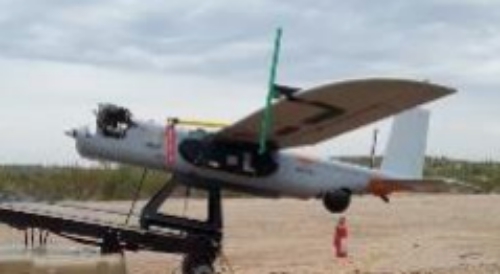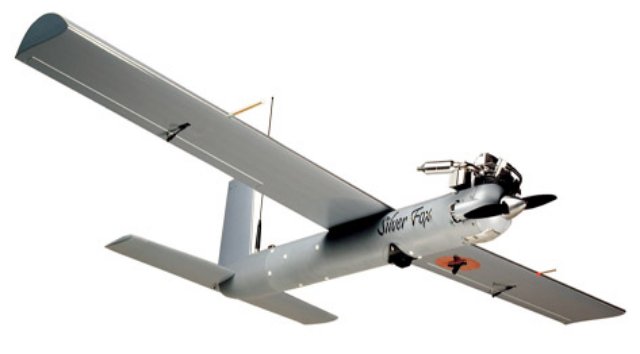Very little information about the Silver Fang unmanned aerial system is available online. But it emerged within data on aviation mishaps obtained by Military Times, painting a fascinating portrait of a little-known technology, and revealing for the first time the extent of Silver Fang testing in Afghanistan.
“Silver Fang was an Air Force Research Laboratory program that provided intelligence, surveillance and reconnaissance capability based on a Tier II, runway-independent small unmanned aerial system,” said Daryl Mayer, a spokesman for Wright-Patterson Air Force Base in Ohio, where AFRL is located.
A photo of the aircraft featured in an August 2015 AFRL presentation shows a fixed-wing, rail-launched plane with a sensor ball attached at the aft of the aircraft.
According to the AFRL-sponsored website Launch Stories, Silver Fang is a derivative of the Silver Fox UAS originally developed by BAE Systems’ unmanned technologies division, which had been bought by Sensintel and has now become part of Raytheon.
It was originally used in theater to help find terrorists who were placing improvised explosive devices along convoy routes — a mission that it was uniquely suited for due to its size, which was large enough to carry significant payloads while staying small enough to operate very quietly while in flight.
The Silver Fox already hosted an electro-optical, infrared sensor, but AFRL added a radio frequency sensor with a wide field of view to help cue the EO/IR sensor and more quickly identify IEDs, the Launch Stories piece noted.
Silver Fang’s experience in Afghanistan raises interesting questions. How often was it being operated? How successful was it in finding IEDs? Did the continued comms link and propulsion problems have anything to do with why the program was seemingly canceled? Or was it funding?
Defense News contacted Air Force Research Laboratory in the hopes of getting answers to these questions. The organization was able to confirm the existence of the aircraft, but declined to comment further on its past activities for classification reasons.
During a September 2016 hearing in front of a congressional panel, Maj. Gen. Robert McMurry, then the head of AFRL, cited Silver Fang as a success story of how the organization can quickly move technologies from development to the field. However, he also noted the difficulty of transitioning them to programs of record.
“The thing that prevents transition, it is hard to say, but I think it is really just getting the agreement that we are going to transition and how we are going to bring that into the operational fold and which service will pick that bill up and when,” he said.
“Because, usually, the bills aren’t that big, but everybody is so tight on money, just trying to figure out how to plan for that and a timeline is a challenge.”
As for the mishaps, Silver Fang experienced 15 mishaps from FY2014 to 2017, and 11 of those accidents occurred during deployments of the aircraft to Afghanistan, according to the data obtained by Military Times. Later mishaps took place in Turkey and at home station at Wright Patterson Air Force Base, Ohio.
/arc-anglerfish-arc2-prod-mco.s3.amazonaws.com/public/BYE2W5HBNRBJDAOKEY4HKLIEMM.jpg)
Most of those accidents involved a loss of propulsion or communications link. In 10 cases, the aircraft crashed and was defined as “not recovered” or “destroyed,” but all mishaps were labeled Class C — perhaps because the cost of the aircraft is between $50,000 and $500,000.
The Air Force has been impacted by 271 Class A, B and C aviation mishaps involving drones from fiscal years 2011 to 2017.
Of those, 45 incidents not associated with big-name Air Force programs of record like the MQ-9 Reaper MQ-1 Predator or RQ-4 Global Hawk.
Aside from Silver Fang, the data notes mishaps involving drones like Spectral Bat; Aervironment’s RQ-20 Puma; RQ-16 T Hawk; the Boeing-Insitu Integrator; Penguin B, a small drone made by Latvian manufacturer UAV Factory; Aerovironment’s RQ-12 Wasp; Lockheed Martin’s Fury B; and Sand Dragon.
It also documents a previously-known 2015 crash of a high-altitude long endurance drone, the experimental X-56A created by Lockheed Martin Skunkworks. According to the mishap data turned over to Military Times, the aircraft was “damaged on landing,” but recovered, resulting in a class C mishap.
While a handful of entries include no data about the UAS at all, two are especially intriguing. Two Class A incidents — a June 2016 event in the United Arab Emirates, followed by an August 2016 mishap where an unnamed drone from Muwaffaq Salti Air Base in Jordan crashed in Djibouti — resulted in the destruction of two unnamed drones valued at more than $2 million.
Others were almost comical, such as an 2012 Class C accident where an unnamed drone flew into an aerostat in Kuwait, destroying both the UAS and the balloon.
Source: Defense News

